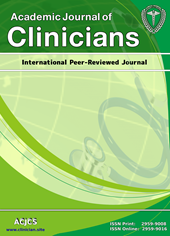Evaluation of Antibiotic Resistance in Escherichia Coli within Nosocomial Urinary Tract Infections in Primary and Hospital Care Facilities
Keywords:
Urinary Tract Infections, Nosocomial, Escherichia Coli, Antibiotic resistance.Abstract
Background: Morbidity from urinary tract infections is high; of all reported infections worldwide, more than 30% are due to UTIs, of which the most common uropathogen is Escherichia coli (E. coli). Empirical prescription of antimicrobials for UTIs is common practice; consequently, bacterial resistance to antimicrobials has increased globally, with a consequent decrease in the effectiveness of empirical treatment.
Objective: To determine the in vitro resistance of the most frequent uropathogen, Escherichia coli, to various antimicrobials in our Health Sector and to deduce empirical treatment options.
Material and methods: Retrospective descriptive epidemiological study carried from January 1, 2022 to December 31, 2024, E. coli strains isolated from urine cultures of patients from Primary and Hospital Care in the our health Sector were studied. A total of 42004 samples were processed. The sensitivity to eleven frequently used antibiotics was determined. The existence of statistically significant differences in sensitivity in the years studied was analyzed, comparing their corresponding 95% confidence intervals (Fisher's method).
Results: E. coli was the most frequently isolated bacterium during the study period. The resistance has been maintained below 4% against fosfomycin and nitrofurantoin and below 12% against third-generation cephalosporins. In cefuroxime and amoxicillin-clavulanic a significant increase in resistance has been observed in hospital strains with respect to those of the community in this period. The highest levels of resistance (greater than 20%) were found in the antibiotics administered orally and frequently indicated in uncomplicated urinary infections: trimethoprim-sulfamethoxazole, ciprofloxacin and amoxicillin.
Conclusion: Fosfomycin, nitrofurantoin or second-generation cephalosporins was the first choice treatment for UTIs
Cite the article as:
Jassim A.R., Abdalrazak A.M., Sulaiman Y.S., Evaluation of Antibiotic Resistance in Escherichia Coli within Nosocomial Urinary Tract Infections in Primary and Hospital Care Facilities. Academic Journal of Clinicians, 2025; 7 (3): 105-13.
Downloads
References
Aryee A, Rockenschaub P, Robson J, Priebe M, Ahmed Z, Nic Fhogartaigh C, Ball D, Hayward A, Shallcross L. Hospital admission after primary care consultation for community-onset lower urinary tract infection: a cohort study of risks and predictors using linked data. British Journal of General Practice. 2023 May 2.
Schmiemann G, Hoffmann F, Hamprecht A, Jobski K. Patterns and trends of antibacterial treatment in patients with urinary tract infections, 2015–2019: an analysis of health insurance data. BMC primary care. 2022 Aug 11;23(1):204.
Mancuso G, Midiri A, Gerace E, Marra M, Zummo S, Biondo C. Urinary tract infections: the current scenario and future prospects. Pathogens. 2023 Apr 20;12(4):623.
Storme O, Tirán Saucedo J, Garcia-Mora A, Dehesa-Dávila M, Naber KG. Risk factors and predisposing conditions for urinary tract infection. Therapeutic advances in urology. 2019 Mar;11:1756287218814382.
Hickling DR, Sun TT, Wu XR. Anatomy and physiology of the urinary tract: relation to host defense and microbial infection. Urinary tract infections: Molecular pathogenesis and clinical management. 2017 Feb 15:1-25.
Alós JI. Epidemiology and etiology of community-acquired urinary tract infection. Antimicrobial susceptibility of the main pathogens and clinical significance of resistance. Infectious Diseases and Clinical Microbiology. 2005 Dec 1;23:3-8.
Yagui M. Antimicrobial resistance: a new approach and opportunity. Revista peruana de medicina experimental y salud publica. 2018 Jan 1;35(1):7-8.
Majumder MM, Mahadi AR, Ahmed T, Ahmed M, Uddin MN, Alam MZ. Antibiotic resistance pattern of microorganisms causing urinary tract infection: a 10-year comparative analysis in a tertiary care hospital of Bangladesh. Antimicrobial Resistance & Infection Control. 2022 Dec 10;11(1):156.
Foxman B. Epidemiology of urinary tract infections: incidence, morbidity, and economic costs. Am J Med. 2002;113 Suppl 1A:S5-13.
Alwan NH, Ramadan GM, Hamad AK, Altammimi S, Omar TM, Azeez M, Al-Jassani MJ. Bacteria causing UTI in patients at Abu Ghraib, Iraq: isolation and identification. J Commun Dis E. 2023 May 29;19:98-101.
Liang H, Zhang J, Hu J, Li X, Li B. Fluoroquinolone residues in the environment rapidly induce heritable fluoroquinolone resistance in Escherichia coli. Environmental Science & Technology. 2023 Mar 14;57(12):4784-95.
Mączyńska B, Frej-Mądrzak M, Sarowska J, Woronowicz K, Choroszy-Król I, Jama-Kmiecik A. Evolution of antibiotic resistance in Escherichia coli and Klebsiella pneumoniae clinical isolates in a multi-profile hospital over 5 years (2017–2021). Journal of Clinical Medicine. 2023 Mar 21;12(6):2414.
Economou V, Gousia P. Agriculture and food animals as a source of antimicrobial-resistant bacteria. Infect Drug Resist. 2015; 8:49.
Mouhammed K, Gdoura R. Study of the genomic characterization of antibiotic-resistant Escherichia Coli isolated from Iraqi patients with urinary tract infections. Indian Journal of Microbiology. 2024 Jun;64(2):457-66.
Betrán A, Lavilla MJ, Cebollada R, Calderón JM, Torres L. Antibiotic resistance of Escherichia coli in nosocomial and community-acquired urinary tract infections in the Huesca Health Sector 2016-2018. Clinical Journal of Family Medicine. 2020;13(3):198-202.
Africa CW, Nel J, Stemmet M. Anaerobes and bacterial vaginosis in pregnancy: virulence factors contributing to vaginal colonisation. International journal of environmental research and public health. 2014 Jul;11(7):6979-7000.
Junquera S, Loza E, Baquero F. Evolution of the sensitivity pattern of Escherichia coli isolates in urine cultures from hospital and community settings. Infectious Diseases and Clinical Microbiology. 2005 Apr 1;23(4):197-201.
Mahdizade Ari M, Dashtbin S, Ghasemi F, Shahroodian S, Kiani P, Bafandeh E, et al. Nitrofurantoin: properties and potential in treatment of urinary tract infection: a narrative review. Frontiers in cellular and infection microbiology. 2023 Jul 27;13:1148603.
Muller AE, Verhaegh EM, Harbarth S, Mouton JW, Huttner A. Nitrofurantoin's efficacy and safety as prophylaxis for urinary tract infections: a systematic review of the literature and meta-analysis of controlled trials. Clinical Microbiology and infection. 2017 Jun 1;23(6):355-62.
Tena D, Praetorius AG, González JC, Heredero E, Illescas S, de Baranda CS, del Olmo GS. Evolution of the susceptibility pattern of Escherichia coli in community-diagnosed urinary tract infections during the period 2003-2007: A multicenter study in Castilla la Mancha. Spanish Journal of Chemotherapy. 2010;23(1):36-42.





